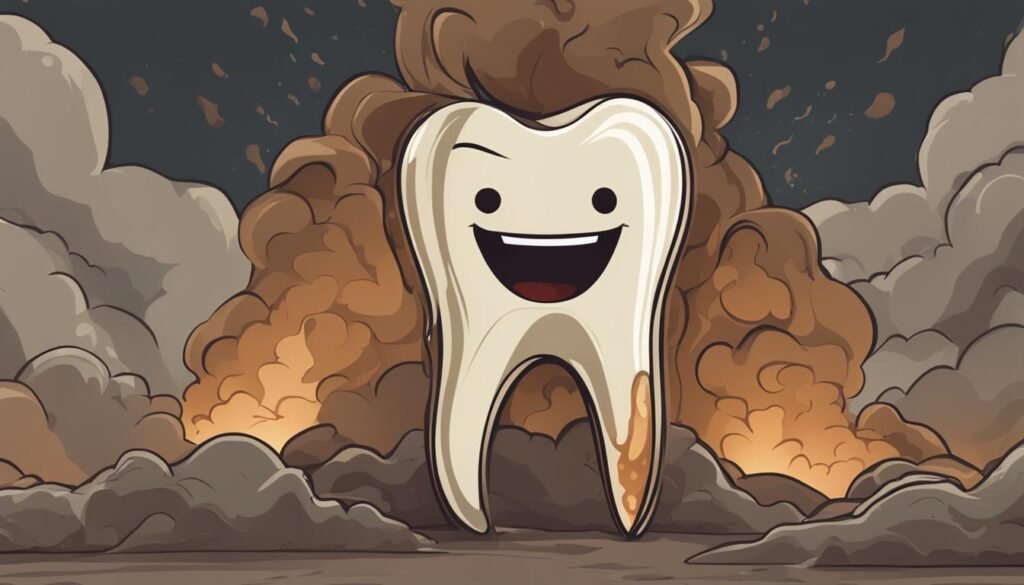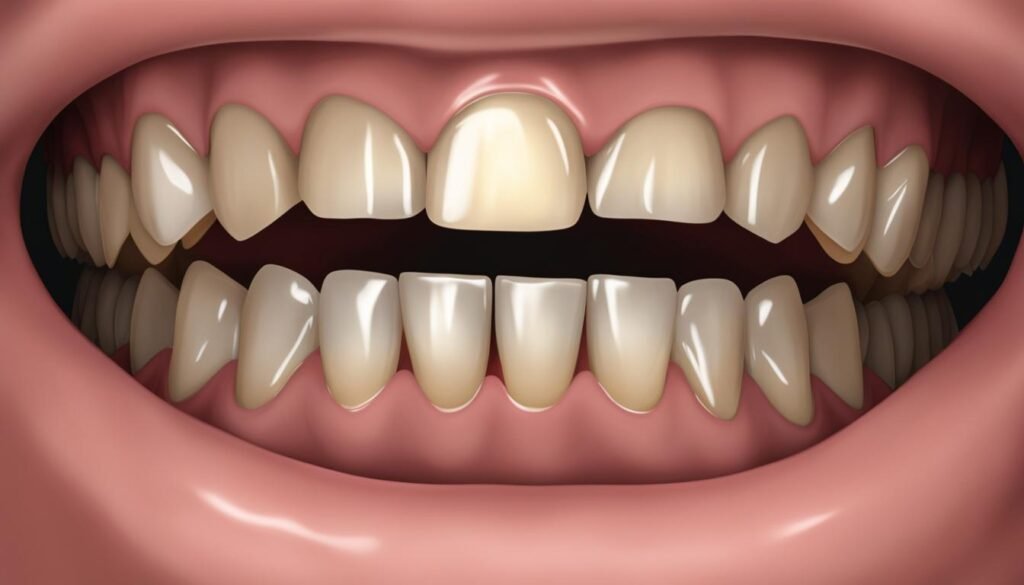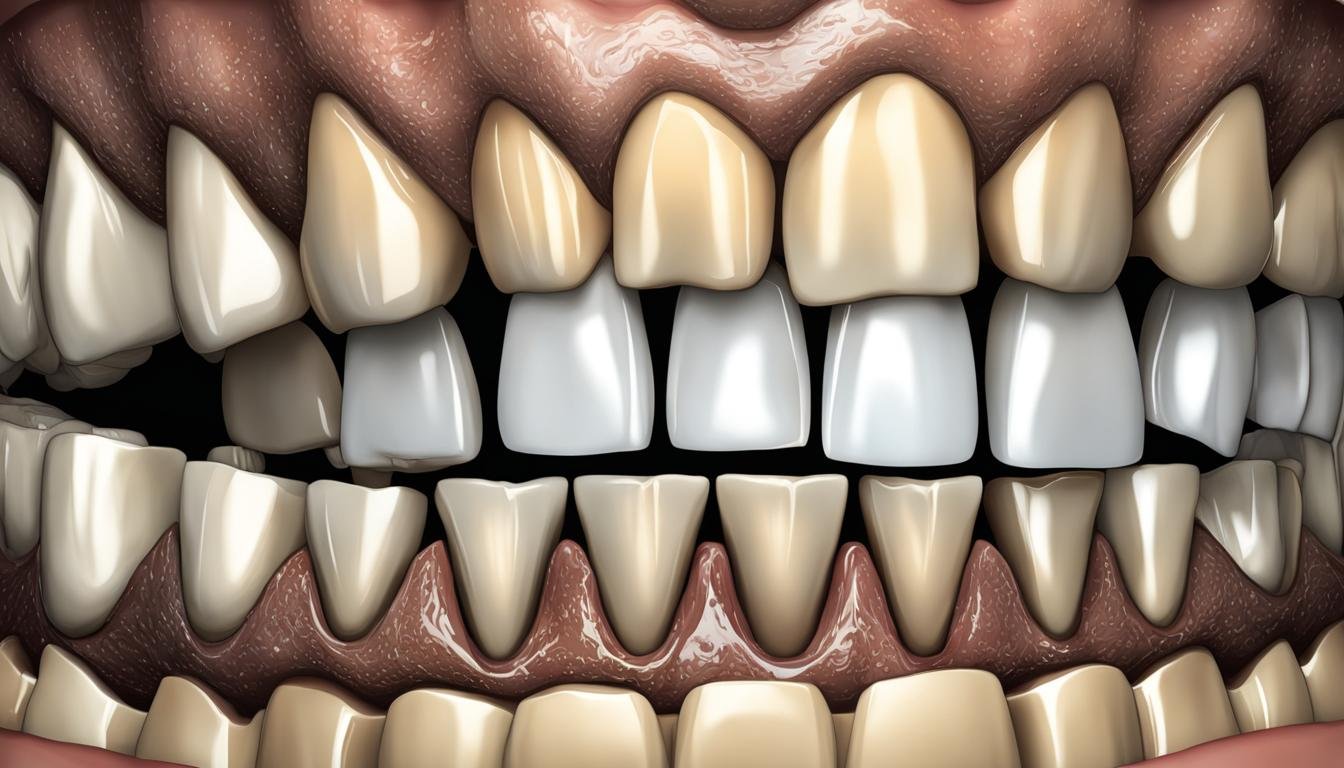Are you concerned about the brown discoloration you’ve noticed at your gum line? Don’t worry, you’re not alone. Many people experience this common dental issue, and there are several possible causes behind it. Understanding the reasons for teeth turning brown can help you address the problem and maintain a healthy smile.
Key Takeaways:
- Tartar buildup, tooth decay, dental stains, tobacco use, medications, fluorosis, and aging can all contribute to brown teeth at the gum line.
- Regular dental cleanings, brushing, and flossing are essential for preventing tartar buildup and tooth decay.
- Limiting consumption of stain-causing foods and beverages, rinsing the mouth after exposure, and using a straw can help prevent dental stains.
- Tobacco use, including smoking and vaping, can cause brown spots on teeth, and quitting is recommended for oral health.
- Some medications, particularly liquid forms, may lead to tooth discoloration, and consulting with a dentist is important in such cases.
By taking proper care of your oral hygiene and addressing the underlying causes, you can prevent and manage brown discoloration at the gum line. Remember to consult with a dental professional if the discoloration persists or worsens, as they can provide tailored advice and treatments for your specific situation.
Tartar Buildup as a Cause of Brown Teeth
Dental hygiene plays a crucial role in maintaining the health and appearance of our teeth. When oral hygiene practices like brushing and flossing are inadequate, tartar buildup can occur. Tartar, also known as dental calculus, is a hardened form of dental plaque that adheres to the teeth and gum line. The porous nature of tartar makes it susceptible to discoloration from foods, beverages, and other factors, leading to brown stains between teeth.
To prevent tartar buildup and its associated discoloration, it is essential to establish a regular oral hygiene routine. This includes brushing your teeth at least twice a day with a fluoride toothpaste and flossing daily to remove plaque and food particles. Regular dental cleanings by a dental professional are also recommended to remove any tartar accumulation that may have occurred.
Furthermore, tartar buildup can contribute to the development of gum disease, a common oral health problem characterized by redness, inflammation, and bleeding of the gums. By addressing tartar buildup through proper oral hygiene practices and professional cleanings, you can reduce the risk of gum disease and its potential impact on the appearance of your teeth.
Preventing Tartar Buildup:
- Brush your teeth at least twice a day using a fluoride toothpaste.
- Floss daily to remove plaque and food particles from between your teeth.
- Use an antimicrobial mouthwash to kill bacteria and prevent plaque formation.
- Avoid sugary and sticky foods that can promote plaque buildup.
- Quit smoking, as tobacco use can contribute to tartar formation.
Regular dental cleanings and a proper oral hygiene routine are essential for removing tartar and preserving the overall health and appearance of your teeth.
Tooth Decay and Brown Teeth
Tooth decay is a common cause of brown spots between teeth. When you consume excessive amounts of sugary and starchy foods, the bacteria in your mouth produce acids that attack the tooth enamel. Over time, this can lead to enamel damage and discoloration. It’s essential to understand the factors that contribute to tooth decay and take preventive measures to maintain good oral health.
Plaque, a sticky film of bacteria, forms on the tooth surface when you consume sugary foods. If not removed through proper brushing and flossing, plaque can harden into tartar, which provides an ideal environment for bacteria to thrive. The acids released by these bacteria can cause tooth decay, leading to brown spots between teeth. Regular dental cleanings and adopting a thorough oral hygiene routine are vital for removing plaque and preventing tooth decay.
Preventing Tooth Decay:
- Brush your teeth at least twice a day with fluoride toothpaste.
- Floss daily to remove plaque from between the teeth and along the gum line.
- Avoid consuming excessive amounts of sugary and starchy foods.
- Rinse your mouth with water after eating or drinking sugary substances.
- Visit your dentist regularly for check-ups and professional cleanings.
If tooth decay has already caused brown spots between your teeth, various treatment options are available. Fluoride treatments can help prevent further decay and remineralize the enamel. Fillings are used to restore damaged areas of the tooth, while crowns may be necessary for more extensive decay. In severe cases, a root canal procedure might be required to remove the infected pulp and save the tooth.
It’s important to address tooth decay promptly to prevent further damage and maintain a healthy smile. If you notice brown spots between your teeth or experience any other dental concerns, consult with your dentist for appropriate diagnosis and treatment.
Dental Stains and Brown Teeth
Brown teeth can be unsightly and may be caused by various factors, including dental stains from the consumption of certain foods and beverages. Staining occurs on the outer surface of the teeth, known as enamel, and can result in brown spots between teeth. The good news is that there are steps you can take to prevent and minimize dental stains.
One of the key culprits of dental stains is the consumption of stain-causing foods and beverages. Popular culprits include coffee, red wine, tea, dark sauces, and fruits like blueberries and blackberries. When these substances come into contact with the teeth, they can leave behind pigmented compounds that cause discoloration.
To help prevent dental stains, it is recommended to rinse your mouth with water after consuming stain-causing substances. This can help remove some of the pigmented compounds from the surface of the teeth. Additionally, using a straw when drinking beverages can help limit tooth exposure to stain-causing substances.
Tips to Prevent Dental Stains:
- Rinse your mouth with water after consuming coffee, red wine, tea, dark sauces, and other stain-causing substances.
- Use a straw when drinking stain-causing beverages to minimize tooth exposure.
- Brush your teeth regularly with a whitening toothpaste to help remove surface stains.
- Consider professional teeth whitening treatments for more stubborn stains.
By following these tips and maintaining good oral hygiene habits, you can help prevent dental stains and keep your teeth looking brighter and healthier.
Tobacco Use and Brown Teeth
Tobacco use, including smoking, vaping, and smokeless tobacco, can have detrimental effects on your dental health. Not only does tobacco use increase the risk of gum disease, oral cancer, and other serious oral health conditions, but it can also cause brown spots on your teeth.
When you smoke or use other tobacco products, the chemicals and substances present in the tobacco can stain the teeth, especially in areas where the tobacco is held. These brown spots are not only aesthetically displeasing, but they can also indicate significant damage to the tooth enamel.

To address the staining caused by tobacco use and prevent further damage, it is crucial to take steps to quit or reduce tobacco consumption. Regular brushing with a toothpaste specifically designed to remove tobacco stains can help minimize the discoloration. Additionally, professional teeth whitening treatments can effectively remove the brown spots and restore the natural whiteness of your teeth.
By quitting tobacco use, you not only improve your dental health but also reduce your risk of developing numerous other health problems, such as heart disease and lung cancer. If you need assistance with tobacco cessation, consider reaching out to your healthcare provider or joining a support program to increase your chances of success.
Medications and Brown Teeth
Certain medications, particularly in liquid form, can lead to tooth staining and discoloration between teeth. Medications used to treat gum disease, for example, may cause brown spots. It is important to be aware of the potential side effects of medications on your oral health.
If you suspect that medications are causing the brown stains on your teeth, it is recommended to consult with your dentist. They can evaluate the discoloration and determine if it is surface-level staining or an underlying issue. Depending on the cause and severity of the discoloration, different treatment options may be recommended.
In some cases, if the staining is surface-level, professional cleaning or whitening procedures may help remove the discoloration. However, if the discoloration is due to underlying issues, such as enamel damage or medication-induced changes in the tooth structure, more extensive restorative or cosmetic procedures may be necessary.
Medicated Rinses
One potential solution to address medication-related tooth discoloration is through the use of medicated rinses. These rinses contain ingredients that can help mitigate staining and improve the overall appearance of your teeth. It is important to follow the instructions provided by your dentist or healthcare professional when using these rinses to ensure optimal results.
Remember, always consult with your dentist or healthcare provider if you have any concerns about tooth discoloration or suspect that your medications may be contributing to the issue. They can provide you with the necessary guidance and treatment options to help restore the natural color and health of your teeth.
Fluorosis and Brown Teeth
Fluorosis is a condition that can cause dental discoloration, including brown stains between teeth. It occurs when there is excessive ingestion of fluoride during tooth development, often from natural mineral levels or well water. While fluoride is beneficial for strengthening tooth enamel, excessive exposure can lead to fluorosis and aesthetic concerns.
Fluorosis-related brown stains are typically caused by the incorporation of excessive fluoride into the developing enamel. This can result in the formation of porous areas that can trap stains, leading to discoloration between teeth. The severity of the stains can vary, ranging from barely noticeable white specks to more pronounced brown discoloration.
If you suspect that you or your child has fluorosis-related brown teeth, it is advisable to consult with a dentist for an accurate diagnosis. Treatment options for fluorosis-related discoloration may involve restorative or cosmetic procedures to address the stains and any enamel damage. These can include teeth whitening, veneers, bonding, or crowns, depending on the individual case.
Preventing Fluorosis and Brown Teeth
To prevent fluorosis and associated brown teeth, it is important to monitor fluoride intake, particularly in young children. Be mindful of the fluoride content in drinking water and consult with your dentist or local water authorities if you have concerns. Using a pea-sized amount of fluoride toothpaste for children under six years old and supervising brushing to minimize swallowing can also help prevent excessive fluoride consumption.
- Avoid using fluoridated toothpaste for children under two years old, unless recommended by a dentist.
- Teach young children to spit out toothpaste and rinse thoroughly after brushing.
- Consider using non-fluoridated toothpaste or water filters if necessary.
By being mindful of fluoride intake and practicing good oral hygiene habits, you can help prevent fluorosis and reduce the risk of developing brown teeth. Regular dental checkups and professional cleanings are also essential for maintaining optimal dental health and addressing any concerns early on.

Conclusion
Brown discoloration at the gum line can be a common dental concern, but it is important to understand the underlying causes and take preventive measures to maintain optimal dental health. By addressing factors such as tartar buildup, tooth decay, dental stains, tobacco use, medications, fluorosis, and aging, you can help prevent and manage brown teeth.
One of the key steps in brown teeth prevention is maintaining a regular oral hygiene routine. This includes brushing your teeth twice a day with a fluoride toothpaste, flossing daily, and using an antimicrobial mouthwash. Additionally, visiting your dentist regularly for professional cleanings and checkups is essential for removing tartar buildup and detecting any dental issues early on.
It is also important to be mindful of stain-causing substances such as coffee, tea, tobacco, and certain foods. Limiting your consumption of these substances and rinsing your mouth with water afterward can help prevent dental staining. If you are a tobacco user, quitting smoking or other tobacco habits can not only prevent brown teeth but also improve your overall oral and general health.
If you notice any persistent or worsening brown discoloration at the gum line, it is recommended to seek professional help from your dentist. They can provide personalized advice and treatment options to address the specific cause of the discoloration, whether it’s through cleaning, whitening procedures, restorative treatments, or other appropriate measures.
FAQ
Why are my teeth turning brown at the gum line?
There are several possible causes for brown discoloration at the gum line, including tartar buildup, tooth decay, dental stains, tobacco use, medications, fluorosis, and aging.
What causes tartar buildup and brown stains between teeth?
Tartar buildup occurs due to inadequate oral hygiene practices like infrequent brushing and flossing. This can lead to brown discoloration between teeth and along the gum line. Regular dental cleanings and a proper oral hygiene routine are essential for removing tartar and preventing gum disease.
How does tooth decay contribute to brown teeth?
Consuming excessive amounts of sugary and starchy foods can lead to tooth decay, which in turn can result in brown spots between teeth. Plaque accumulates on the tooth surface, causing enamel damage and discoloration. Treatment options for tooth decay include fluoride treatments, fillings, crowns, and root canal procedures.
What causes dental stains and brown teeth?
Dental stains can be caused by the consumption of certain foods and beverages, such as coffee, red wine, tea, dark sauces, and fruits like blueberries and blackberries. Staining occurs on the outer surface of the tooth (enamel). Rinsing the mouth with water after consuming stain-causing substances and using a straw to limit tooth exposure can help prevent staining.
Can tobacco use lead to brown spots on teeth?
Yes, tobacco use, including smoking, vaping, and smokeless tobacco, can cause brown spots on teeth, especially behind the front teeth and in areas where the tobacco is held. Regular brushing, professional teeth whitening, and tobacco cessation are recommended to address the staining caused by tobacco use.
Do certain medications cause tooth discoloration?
Yes, certain medications, particularly in liquid form, can lead to tooth staining and discoloration between teeth. Medications used to treat gum disease, for example, may cause brown spots. If the discoloration is surface-level, cleaning or whitening procedures may help remove it. It is important to consult with a dentist if you suspect medications are causing the brown stains.
What is fluorosis and how does it cause brown teeth?
Fluorosis can occur when there is excessive ingestion of fluoride during tooth development, often from natural mineral levels or well water. Brown staining between teeth can be a result of fluorosis. Treatment options may involve restorative or cosmetic procedures to address the discoloration or enamel damage caused by fluorosis.
How can I prevent and address brown teeth?
Maintaining a regular oral hygiene routine, visiting the dentist for cleanings and checkups, and avoiding stain-causing substances can help prevent and address brown teeth. It is important to seek professional help if the discoloration persists or worsens.

